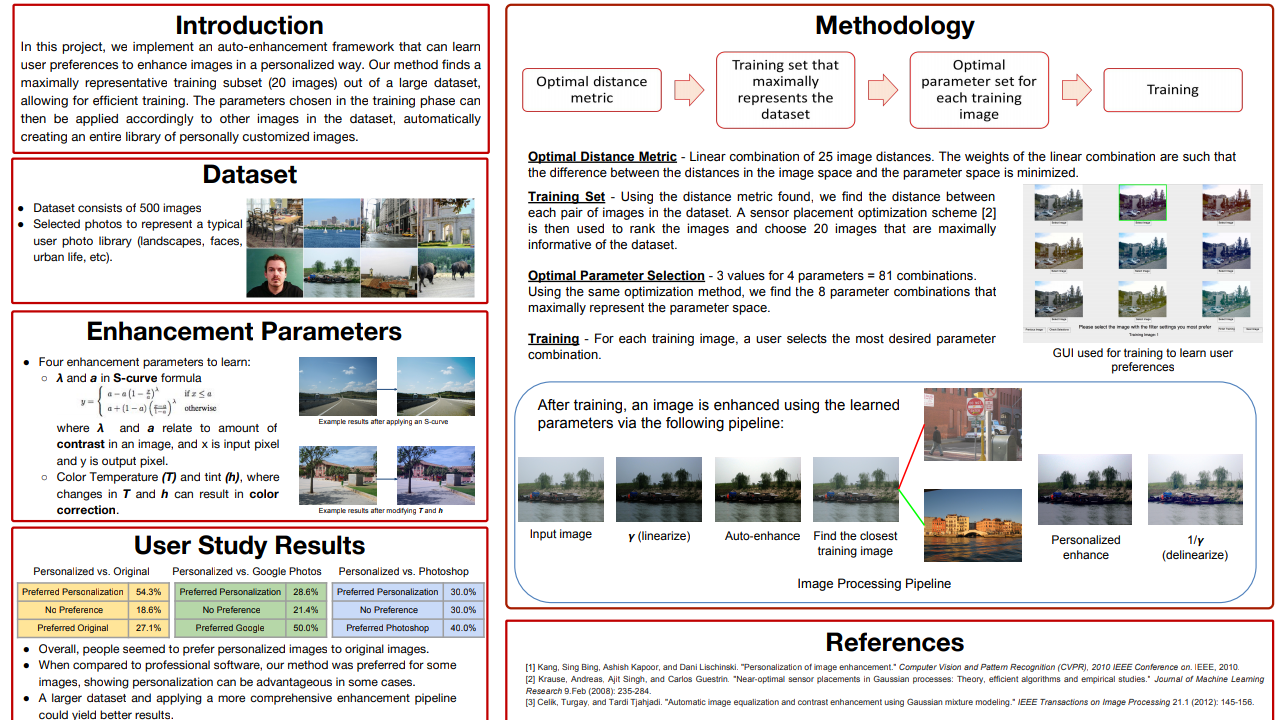Image Enhancement using Machine Learning
Image Enhancement using Machine Learning
OUTPUT
OVERVIEW
Automatic image enhancement is an active field of research and is used widely in professional image processing software. For our project, we want to create an automatic image enhancement tool that learns a user’s preferences so that subsequent images can be automatically enhanced in a personalized
way. Our work will be mainly derived from [1]. The parameters learned in [1] are associated with
contrast and color correction. We will attempt to learn these parameters, and if time permits, experiment with other parameters as well.
The first part of this project is to select an optimal subset of training images from a large set of
images, using the optimization technique described in [1] and [3]. The subset will be around 15-20
training images. For each training image, there will be a large possible number of combinations of
parameters (depending on how many we choose to learn). To reduce the subset of possible parameter
combinations used for training, we can apply the same optimization mentioned earlier. In the end, we will get 8-10 “optimal” parameter combinations per training image, which again represent the parameter space maximally. By doing these two steps, the amount of training time per user is lower, and the number of computations to train is also lower. After we have our training set, we will perform user studies on 5 to 7 subjects to acquire personalized training data. The parameter selection algorithm essentially uses a distance metric to find the closest neighbor in the training set to the test image and applies the parameters accordingly. We plan to form an optimal linear combination of multiple distance metrics to best match the test image. We will then test our algorithm and compare results to a few professional auto enhancement tools. Also, if time permits, we would like to make the enhancement tool more content aware using some principles mentioned in [2]. Techniques in [4] can also be used to preprocess the image before the personalized enhancement step.
In conclusion, we expect the results of the user study to indicate whether or not people would
prefer a personalized enhancement tool over a conventional auto-enhancement tool found in common
image processing software.
We will NOT be using an Android device
References:
[1] Kang, Sing Bing, Ashish Kapoor, and Dani Lischinski. "Personalization of image enhancement."
Computer Vision and Pattern Recognition (CVPR), 2010 IEEE Conference on. IEEE, 2010.
[2] Kaufman, Liad, Dani Lischinski, and Michael Werman. "Content-Aware Automatic Photo
Enhancement." Computer Graphics Forum. Vol. 31. No. 8. Blackwell Publishing Ltd, 2012.
[3] Krause, Andreas, Ajit Singh, and Carlos Guestrin. "Near-optimal sensor placements in Gaussian
processes: Theory, efficient algorithms and empirical studies." Journal of Machine Learning Research
9.Feb (2008): 235-284.
[4] Celik, Turgay, and Tardi Tjahjadi. "Automatic image equalization and contrast enhancement using
Gaussian mixture modeling." IEEE Transactions on Image Processing 21.1 (2012): 145-156.
FOR BASE PAPER PLEASE MAIL US
DOWNLOAD SOURCE CODE CLICK HERE
OUTPUT
OVERVIEW
Automatic image enhancement is an active field of research and is used widely in professional image processing software. For our project, we want to create an automatic image enhancement tool that learns a user’s preferences so that subsequent images can be automatically enhanced in a personalized
way. Our work will be mainly derived from [1]. The parameters learned in [1] are associated with
contrast and color correction. We will attempt to learn these parameters, and if time permits, experiment with other parameters as well.
The first part of this project is to select an optimal subset of training images from a large set of
images, using the optimization technique described in [1] and [3]. The subset will be around 15-20
training images. For each training image, there will be a large possible number of combinations of
parameters (depending on how many we choose to learn). To reduce the subset of possible parameter
combinations used for training, we can apply the same optimization mentioned earlier. In the end, we will get 8-10 “optimal” parameter combinations per training image, which again represent the parameter space maximally. By doing these two steps, the amount of training time per user is lower, and the number of computations to train is also lower. After we have our training set, we will perform user studies on 5 to 7 subjects to acquire personalized training data. The parameter selection algorithm essentially uses a distance metric to find the closest neighbor in the training set to the test image and applies the parameters accordingly. We plan to form an optimal linear combination of multiple distance metrics to best match the test image. We will then test our algorithm and compare results to a few professional auto enhancement tools. Also, if time permits, we would like to make the enhancement tool more content aware using some principles mentioned in [2]. Techniques in [4] can also be used to preprocess the image before the personalized enhancement step.
In conclusion, we expect the results of the user study to indicate whether or not people would
prefer a personalized enhancement tool over a conventional auto-enhancement tool found in common
image processing software.
We will NOT be using an Android device
References:
[1] Kang, Sing Bing, Ashish Kapoor, and Dani Lischinski. "Personalization of image enhancement."
Computer Vision and Pattern Recognition (CVPR), 2010 IEEE Conference on. IEEE, 2010.
[2] Kaufman, Liad, Dani Lischinski, and Michael Werman. "Content-Aware Automatic Photo
Enhancement." Computer Graphics Forum. Vol. 31. No. 8. Blackwell Publishing Ltd, 2012.
[3] Krause, Andreas, Ajit Singh, and Carlos Guestrin. "Near-optimal sensor placements in Gaussian
processes: Theory, efficient algorithms and empirical studies." Journal of Machine Learning Research
9.Feb (2008): 235-284.
[4] Celik, Turgay, and Tardi Tjahjadi. "Automatic image equalization and contrast enhancement using
Gaussian mixture modeling." IEEE Transactions on Image Processing 21.1 (2012): 145-156.
FOR BASE PAPER PLEASE MAIL US
DOWNLOAD SOURCE CODE CLICK HERE




Comments
Post a Comment